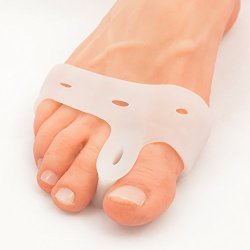$13.99
$13.99
(SAVE Now!)
as of 12/22/2024 (Details)
DON'T SUFFER IN SILENCE LIKE MILLIONS OF OTHERS Hallux Valgus Deformity--aka bunions--is seen in up to 23% of adults > 18 years old and over 35% of adults > 60 years old. Stop walking around in pain all day. Get relief now! Why Dr. Frederick's Original Bunion Pad & Spacer Kit? Our super soft & stretchy gel pads are designed to provide light varus pressure to provide gentle realignment of your big toe while wearing shoes or while barefoot. Improved alignment and separation of the big toe and second toe provides pain relief for many people. Includes: 2 Deluxe Bunions Pads
Technical Details
- RELIEVE PAIN FROM BUNIONS & TAILOR'S BUNIONS: Not only does our deluxe spacer work great for regular bunions by straightening the big toe and providing extra padding, but it's also great for padding a tailor's bunion that causes pain on the outside of your fifth toe.
- DESIGNED FOR AN ACTIVE LIFESTYLE: We know that you do more than just sit around all day. That's why our deluxe spacer is designed to fit securely around your forefoot and stay in place. Try wearing it in your favorite shoes to experience the added comfort.
- POSTPONE YOUR NEED FOR SURGERY: Nothing can replace corrective bunion surgery, but our cushions, pads, spacers, and shields often provide enough relief that you can get back to your normal routine. Stop struggling with foot pain and find immediate relief with Dr. Frederick's Original Deluxe Bunion Pad & Toe Spacer
- AN IMPORTANT NOTE FROM HAPPY CUSTOMERS: You'll get the best results when worn with snug fitting socks to help keep the pad in place and prevent tearing of the pad and rubbing and blistering of the skin.
- PLEDGE TO ALWAYS BE ETHICAL: The team at 'Dr. Frederick's Original' is headed by medical professionals and will never make unfounded claims about the benefits of our products. Bunion pads & spacers are designed for pain relief both before and after surgery. Some competitors offer a 'cure', but correction of bunions with these and similar devices is not typical and usually requires corrective bunion surgery.
